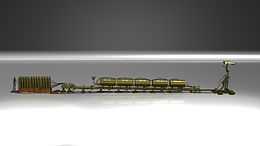Peter Barton (historian)
Peter Arthur Barton (born 28 March 1955) is a First World War historian and author. His body of research includes finding hundreds of previously unseen panoramas, mass graves of soldiers and tunnel excavations. Mr. Barton’s research produced a panoramic collection that allows readers to view the battlefields from the Belgian coast and to the end of the British lines at the Somme.[1]

With his colleague, Jeremy Banning, he released a book on the neglected Battle of Arras. The book, Arras - The Spring 1917 Offensive in Panoramas including Vimy Ridge and Bullecourt was published in June 2010 by Constable. February 2011 saw the release of a revised version of their 2006 Somme panorama book, now titled Somme - the unseen panoramas. Together they are involved in many archaeological projects on the western front including the successful dig in May 2010 at Mametz for surviving pieces of a Livens Large Gallery Flame Projector. This project was undertaken for a television documentary entitled 'Breathing Fire' to be broadcast internationally in Autumn 2011. A version for British television, a Time Team Special entitled 'The Somme's Secret Weapon' was broadcast in April 2011.
He is co-secretary of the All Party Parliamentary War Graves and Battlefields Heritage Group [2] The Group consists of Members from both Houses and exists to support the work of the Commonwealth War Graves Commission, to further educational programmes aimed at increasing knowledge of war heritage and battlefield sites, to support campaigners seeking to conserve and promote heritage sites, and to encourage best practice in multi-disciplinary battlefield archaeology.
He has worked alongside Glasgow University Archaeology Research Division (GUARD),[3] with the work around locating and exploring the mass graves at the Pheasant Wood site at Fromelles.[4][5] He has been commissioned by the Australian Government to carry out research into the identities of the casualties discovered. He was given access to Red Cross records at their headquarters in Geneva. There he was able to examine records that have lain virtually untouched since 1918, and estimates that there could be 20 million sets of details, carefully entered on card indexes, or written into ledgers.[6][7]
Works
- Peter Barton; Peter Doyle; Johan Vandewalle (2005). Beneath Flanders Fields: The Tunnellers' War 1914-1918. McGill-Queen's Press - MQUP. ISBN 978-0-7735-2949-6.
- The Battlefields of the First World War (1st edition - 2005)
- The Somme - a new panoramic perspective, Constable, 2006, ISBN 978-1-84529-399-4
- Passchendaele - Unseen Panoramas of the Third Battle of Ypres, Constable, 2007, ISBN 978-1-84529-422-9
- The battlefields of the First World War: the unseen panoramas of the Western front, Constable in association with the Imperial War Museum, 2005, ISBN 978-1-84119-745-6 (2nd edition - 2008)
- Arras - The Spring 1917 Offensive in Panoramas including Vimy Ridge and Bullecourt, Constable, 2010, ISBN 1-84529-421-1
- The Somme - the unseen panoramas, Constable, (revised edition - 2011), ISBN 978-1-84901-719-0
References
- ↑ "Peter Barton | Military History". Constablerobinson.com. Retrieved 2014-04-22.
- ↑ http://www.wargravesheritage.org.uk www.wargravesheritage.org.uk
- ↑
- ↑ http://www.cwgc.org/fromelles/scripts/download.php?file=158
- ↑ war graves heritage - images and more on Fromelles
- ↑ Piecing together the past - BBC
- ↑ macrusk (2014-04-16). "Original Red Cross Records WWI, WWII Found - Military Service Records & Genealogical Research - WWII Forums". Ww2f.com. Retrieved 2014-04-22.
|